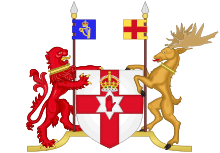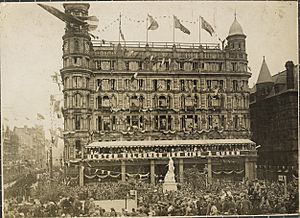Parliament of Northern Ireland facts for kids
Quick facts for kids Parliament of Northern Ireland |
|
|---|---|
| Devolved Parliament | |

Arms of Northern Ireland, 1924–1972
|
|
| Type | |
| Type | |
| Houses | |
| History | |
| Established | 7 June 1921 |
| Disbanded | 30 March 1972 |
| Preceded by | UK Parliament (1801-1921) |
| Succeeded by | Northern Ireland Assembly (1973) |
| Leadership | |
|
Speaker of the Senate
|
Lord Glentoran (last)
|
|
Ivan Neill (last)
|
|
| Elections | |
| Elected by the Commons via STV | |
|
|
| Meeting place | |
 |
|
| Parliament Buildings, Stormont, Belfast | |
The Parliament of Northern Ireland was the main law-making body for Northern Ireland for over 50 years. It was set up in 1921 under a law called the Government of Ireland Act 1920. This Parliament allowed Northern Ireland to have its own government, separate from the rest of the United Kingdom.
The Parliament started meeting on 7 June 1921. It continued until 30 March 1972. At that time, it was stopped because it couldn't control the violence during a difficult period known as The Troubles. This led to "Direct Rule", meaning the UK government in London took over running Northern Ireland. The Parliament was officially ended in 1973.
The Parliament of Northern Ireland had two parts, like many parliaments around the world. This is called being "bicameral". It had a House of Commons with 52 members. It also had a Senate with 26 members, who were chosen indirectly. The King or Queen was represented by the Governor. The Governor gave "royal assent" to new laws, which meant approving them. However, the real power was with the Prime Minister. The Prime Minister was the leader of the biggest political party in the House of Commons.
Contents
How the Parliament Worked
The House of Commons
The House of Commons had 52 members. Most of these members represented different areas of Northern Ireland. Four members represented graduates from Queen's University, Belfast. This changed in 1969, when the university seats were removed. Instead, four new seats were added for different areas.
When the Parliament first started, members were elected using a system called single transferable vote (STV). This system tries to make sure that smaller parties and groups get a fair number of seats. However, the Parliament was allowed to change this system after three years.
Many Unionists did not like the STV system. They felt it made them lose seats. After the 1925 election, where Unionists lost eight seats, the system was changed. From 1929 onwards, most elections used the "first-past-the-post" system. This is where the candidate with the most votes wins, even if they don't get more than half the votes.
The new boundaries for the 1929 election were set by the Unionist government. Some people said this was "gerrymandering". This means drawing election areas to give one party an unfair advantage. However, historians disagree on how much this affected the number of Nationalist members elected. The boundaries stayed mostly the same until the Parliament closed in 1972.
In 1968, the university seats were removed. Four new areas were created around Belfast. This helped the Unionist party, as they won all four new seats. However, many people had been asking for a "one person, one vote" system for a long time. This means every person's vote counts equally.
The Senate
The Senate was added to the Parliament at the last minute. It was meant to be a second chamber to review laws.
Most of the 24 senators were chosen by the House of Commons members. They used the single transferable vote system. These elections happened after each general election. The senators served for two parliamentary terms. The other two seats in the Senate were for the Lord Mayor of Belfast and the Mayor of Derry.
The Senate usually had a similar mix of political parties as the House of Commons. However, parties that chose not to take their seats, or very small parties, were not represented. Because the Senate was chosen by the House of Commons, it didn't have much political power.
The Crown's Role
The British monarch was represented in Northern Ireland by a special person. At first, this was the Lord Lieutenant of Ireland. But this role was ended when the Irish Free State was formed. So, a new role was created: the Governor of Northern Ireland. The first Governor started on 12 December 1922.
Where the Parliament Met
The Parliament first met in Belfast City Hall. Then, from 1921 to 1932, it moved to a college building. The House of Commons met in the college's library. The Senate met in the chapel.
In 1932, the Parliament moved to a new building built just for it. These were the Parliament Buildings at Stormont. Stormont is on the eastern edge of Belfast. Over time, the name "Stormont" became a nickname for the Parliament itself and the Northern Ireland government.
What Laws the Parliament Made
The Parliament at Stormont had the power to make laws about almost everything in Northern Ireland. Only a few things were kept for the UK government in London. These included things like the armed forces, taxes, and postal services.
The Parliament usually followed these rules. Only once did the UK government suggest that the King should not approve a law. This was a law about local government elections. But in the end, the King did give his approval. The Parliament passed many laws for Northern Ireland. Some of these laws were similar to ones recently passed in the UK.
A law from 1922 said that the Parliament could not make any law that treated people differently because of their religion. However, this rule didn't always have a strong effect.
A Quick Look at its History
The first election for the Northern Ireland Parliament in 1921 was very important. It was like a vote on whether Northern Ireland should be separate from the rest of Ireland. This was called "partition". After that, the Prime Minister decided when the next elections would happen.
Elections often took place when there was a new crisis about partition. This usually made Protestant voters support the Unionist Party. Other Unionist candidates or the Northern Ireland Labour Party were often accused of causing problems or helping the Nationalists.
The 1925 election happened because of a report expected from the Irish Boundary Commission. This commission was supposed to suggest changes to the border with the Irish Free State. The Unionist slogan was "Not an Inch!". They lost eight seats in areas where the border issue was less important.
From 1925 to 1927, members of the Nationalist Party started taking their seats in Parliament for the first time.
For the 1929 election, the Unionists changed the voting system. They blamed the previous system for their losses in 1925. With the new system, the Unionists always held at least 33 seats. In the 1930s, the phrase "A Protestant Parliament for a Protestant People" was sometimes used.
During World War II, the Stormont government asked the UK government to introduce conscription (forced military service) in Northern Ireland. This was already happening in Great Britain. But the British government said no. They remembered that a similar attempt in 1918 had caused big problems.
A big change happened in 1965. The Nationalists agreed to become the official opposition party. This was a positive step. It was meant to reward Terence O'Neill for trying to end unfair treatment against Catholics. He also tried to improve relations with the Republic of Ireland.
However, the Unionist party split over O'Neill's changes. In 1971, the new nationalist party, the Social Democratic and Labour Party, left Stormont. They were unhappy that there was no investigation into police actions in Derry.
Stormont was closed down and Direct Rule from London began in March 1972. This happened just after a sad event known as Bloody Sunday. The Unionist government refused to let the UK government take control of law and order.
In its 50-year history, only one law proposed by a Nationalist member was passed. This was the Wild Birds Protection Act. In October 1971, as The Troubles got worse, Gerard Newe was made a junior minister. This was an attempt to improve relations between different communities. He was the first Catholic to serve in the Northern Ireland government.
The Orange Order had a lot of influence in Northern Ireland's government. All six Prime Ministers of Northern Ireland were members of the Order. Almost all cabinet ministers until 1969 were also members. Most Unionist senators were also Orangemen.
You can find a full digital copy of the Commons' debates online.
General Elections and Composition
Key to Parties
- - Anti-Partition of Ireland League
- - Commonwealth Labour Party
- - Fianna Fáil
- - Independent
- - Independent Labour
- - Independent Labour Group
- - Independent Nationalist
- - Independent Unionist
- - Independent Unionist Association
- - Irish Labour Party
- - National Democratic Party
- - Nationalist Party (Northern Ireland)
- - Northern Ireland Labour Party
- - Republican (1923)
- - Republican Labour Party
- - Sinn Féin
- - Socialist Republican Party
- - Ulster Liberal Party
- - Ulster Unionist Party
- - Unbought Tenants Association
See Also


